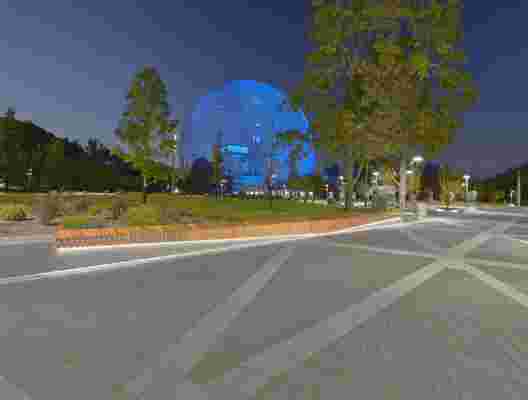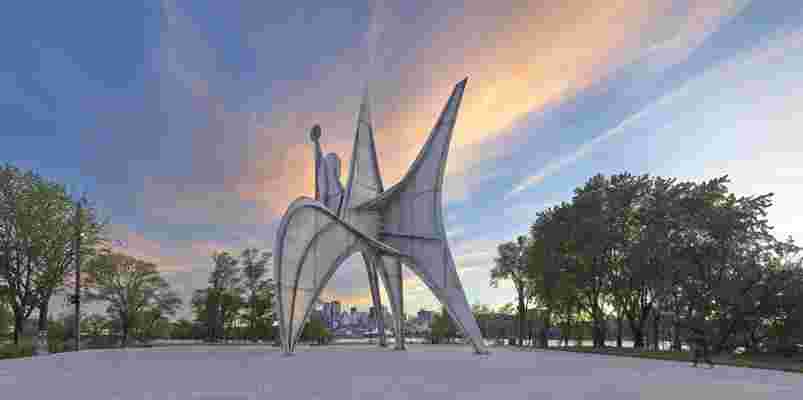Canadian-American architecture firm Lemay’s reimagining of Parc Jean-Drapeau, the legendary site of Montreal’s Expo 67 , brings one of the city’s premier parks into the 21st century and reframes Alexander Calder’s monumental Trois Disques sculpture. “It’s difficult to overstate the importance of this project to our city; it really is a rearticulation of one of our major public spaces. It’s like going in to [New York’s] Central Park and redefining, like, a quarter of the park,” says Andrew King, partner and design principal at Lemay.
The park’s history stretches back to the 19th century, but it was the 1967 World’s Fair, also called Expo 67 and carrying the motto “Man and His World,” that made the version of the island park Montrealers are familiar with today. The festival, which was held to celebrate Canada’s 100th anniversary, drew 50 million visitors to the park, which was linked to the city of Montreal by subway lines and bridges for the first time.

The project cost $60 million in construction, and took two years to complete.
The year 1967 was a different time for the province of Quebec, when Montreal was widely seen as Canada’s cultural and business capital. “Within that era there was a huge building boom in Quebec,” says King, citing the construction that took place in the provincial capital for Expo 67 as well as the 1976 Olympics a few years later. In the years since the temporary pavilions came down, Toronto largely replaced Montreal as the nation’s commercial heart, though the Expo site on Île Sainte-Hélène remained a public park.
The ultimate resource for design industry professionals, brought to you by the editors of Architectural Digest

The site is still home to some of its most memorable original attractions, including Alexander Calder’s massive Trois Disques sculpture and Buckminster Fuller’s geodesic sphere (originally designed as the American pavilion, it’s now the Montreal Biosphere). But for the past half-century Parc Jean-Drapeau has been a somewhat underused public park and concert venue for open-air festivals such as Osheaga. When Montreal’s 375th anniversary as a city rolled around in 2017, the city announced an ambitious revitalization plan for the park, and tapped Lemay, a well-established local firm with strong master-planning credentials, to reinvigorate the space and create a contemporary park that was engaging at a range of scales.

Alexander Calder’s monumental sculpture Trois Disques.
In order to bring a new sense of dynamism to the space, major changes needed to be made to its layout. “There was no direct visual access across the island, certainly not to the Calder,” says King. “It was more of a kind of meander, and it was heavily forested; there was a lot going on.” He and his team replaced the meander with a more direct “Allée Calder” that connects the metro station directly to the sculpture and views of the city’s skyline beyond, setting up a clear visual orientation to the park.
The layout of the space is much more direct, and easy to navigate for tourists and locals alike.
Additionally, the architects devised service buildings, including a restaurant and restrooms that are so lightly designed they almost disappear into the landscape. Their angular structures make use of glass and perforated aluminum to appear as unobtrusive as possible. It’s a material language that is continued in the amphitheater’s makeover. Handsome perforated aluminum fencing now clearly delineates the concert venue from the surrounding woodland. Built-in furniture and lighting elements, designed to reference Expo 67’s original visual language, meet the comfort and security needs of a 65,000-seat natural amphitheater.
The renewal project, dubbed Espace 67, is not simply the restoration of a historic site to a calcified version of its former glory; it’s essentially a new park, built on an old site that has had many lives. Much like Expo 67 itself, the project is an opportunity for Montreal to assert itself as an international city. Montreal is growing rapidly, and multifaceted public spaces like the refreshed Parc Jean-Drapeau are exactly the type of amenities today’s city dwellers crave. Expo 67 marked a high point in Montreal’s international cultural clout, and it’s King’s belief that a city on the rise again deserves a major contemporary greenspace. “I think Espace 67 is the reengagement of a more global aspiration for Montreal after a couple of decades of having different preoccupations in terms of its identity, a reengagement in an international identity,” he says.
